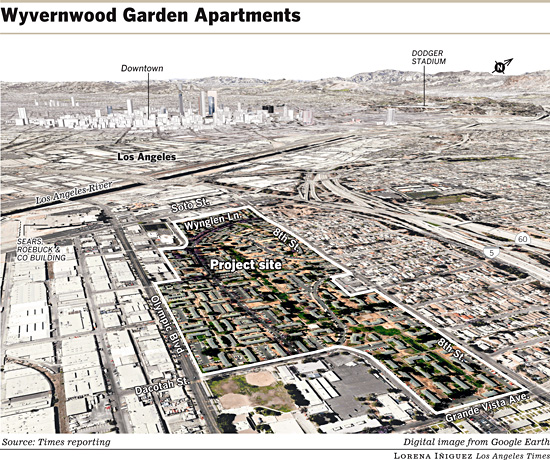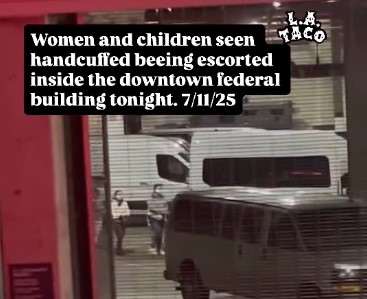(One of the ongoing stories in our Boyle Heights/East Los Angeles coverage has been the debate over whether or not to proceed with the redevelopment of Wyvernwood Garden Apartments. Jesús Hermosillo has a master's degree in urban planning and contributes regularly to Boyle Heights Beat. Streetsblog has not taken a position on the project and welcomes an op/ed by the Fifteen Group or any proponents of the project. - DN)
To save or not to save Wyvernwood Garden Apartments, and build something else in its place, is the question more and more people are grappling with as city officials prepare to decide on the proposed Boyle Heights Mixed Use Community Project. Anti-redevelopment arguments center on preserving a cultural landmark, and averting another mass displacement reminiscent of Chavez Ravine. No matter which side of the debate you fall on, there is no doubt a new Wyvernwood will change Boyle Heights forever. The consequences of the $2.2 billion real-estate venture—one of the largest ever proposed in the United States—could spell an ecological catastrophe for Boyle Heights.

Despite its billing as an exemplar of New Urbanism—an urban-design movement promoting compact, mixed-use, walkable neighborhoods as a green alternative to automobile-reliant development—one of the proposal’s central features is undoing the historic garden community’s pedestrian-oriented design to make way for vastly expanded car facilities.
Fifteen Group, the Miami-based company that owns Wyvernwood, proposes to replace the seventy acre “Garden City” campus containing hundreds of orange-colored buildings, 1,187 homes and over 6,000 residents, with something similar to an Eastside version of Playa Vista,. The proposed development contains 4,400 condominiums and rentals; 325,000 square feet of stores, restaurants and offices, recreational facilities for residents including swimming pools and spas; and parking for 9,048 cars.
Although total parking spaces proposed is over five times more than 1,799 spaces currently on site, the number ultimately built could be higher if Fifteen Group fails to obtain an exemption from city minimum parking rules requiring 10,903 to 11,003 spaces for a project this dense. Fifteen group justifies the project as creating “a healthier place to live and work.” At the same time, the developer wants to continue subsidizing automobile ownership after describing Wyvernwood’s current provision of 1.5 parking spaces per home as “inadequate,” corresponding to “a time when there were fewer automobiles” than today.
Actually, the average number of vehicles owned per Los Angeles household is 1.4—and only 1.1 among renters.
Moreover, listed as a selling point for the project is its proximity to several freeways, the same ones largely responsible for Boyle Heights’s unusually high rates of asthma and other illnesses caused by air pollution. To “improve circulation” within the new complex, Fifteen Group wants to triple the miles of car-accessible roads cutting through the project area, spurning the tree-lined footpaths that are a hallmark of this park-like community.
The developer contends that adding thousands of cars to Boyle Heights streets won’t add to environmental-health woes because new residents are likely to be lured away from their cars by seventeen bus lines serving Wyvernwood’s “immediate surroundings.” But only six of these lines are easy to get to on foot, and only three of these have peak hour headways of fifteen minutes or less. Catching most of the other buses, or the Gold Line over a mile away, requires a brave, long trek past treacherous freeway overpasses or industrial zones.
Nonetheless, the tendency for renters and low-income people of color to walk, bike or use transit—by necessity more than choice—holds true among present-day Wyvernwood residents: 42% already commute to work by some means other than driving, and another 11% carpool. There is no telling if an upscale New Wyvernwood’s population of mostly condo owners would do the same, but we know that higher income commuters generally drive alone.
While the Fifteen Group offers ten acres of publicly available open space in a redeveloped Wyvernwood, ten acres is a fraction of what was once widely enjoyed in the un-gated community. Indeed, longtime tenants often complain about the curtailment of their own use of the grassy grounds—variably estimated at 36 to 50 acres—after Fifteen Group bought the property in 1998.
The megaproject would not only create the most densely populated census tract in Los Angeles, with about 94,000 people per square mile—even with its conservatively projected 2.3 occupants per unit. It would also bring the first set of high rises since the iconic 14-story Sears tower nearby was completed in 1927 to the area of Los Angeles east of the L.A. River. Three buildings would stand at 24 stories, another three at 18, and several more could reach 7 stories.
Given Fifteen Group’s request that the New Wyvernwood be designated a supergraphics special district, Boyle Heights residents may also see one day bright digital billboards atop the new skyscrapers illuminating the night sky.
Finally, as the Los Angeles Conservancy points out, any value in the proposed construction’s “green design” would be undermined by the demolition of 256 buildings that could otherwise be renovated, a cost-effective solution to problems created by years of deferred maintenance. Renovation and reuse are increasingly recognized as more ecologically sustainable than razing and rebuilding. The community’s common depiction as a slum notwithstanding, Los Angeles Housing Department inspectors have found the apartment buildings to be structurally sound, if in need of upgrades.
Wyvernwood’s preservation would also prevent the loss of nearly 1,200 dwellings from the shrinking stock of rent-stabilized housing, the city’s most important supply of affordable rentals.
With such un-New Urbanist truths inherent in the proposal, it was puzzling last year to hear that it had received an award from the Congress for the New Urbanism, a DC-based architectural group advocating New Urbanist principles including pedestrianism, mass transit, historic preservation and diversity.
Providing insight into the decision is planning scholar Mike Davis’s article, “Gentrifying Disaster,” describing the group’s collaboration in African Americans’ exclusion from Gulf Coast communities rebuilding after Hurricane Katrina. Contrary to its charter’s democratic spirit, writes Davis, the CNU’s practice of judging proposals without asking key questions—such as who or what might be replaced, and for whose benefit—puts it in the role of granting “legitimacy and publicity” to some “evil” projects.
“New Urbanism” has become a potent buzzword, however, rallying unquestioning supporters for just about any development at its mere mention. And in Davis’s words: “Smart developers accordingly have been quick to put New Urbanist halos over their otherwise rampant land grabs and neighborhood demolitions.”
A last reason yet to be skeptical about the environmental claims related to redeveloping Wyvernwood—not to mention promises that nobody will be displaced, and that needy local residents will be given affordable housing and thousands of jobs—is Fifteen Group’s track record. The 21-year-old company has no experience in real-estate development, but has made money as a sort of middleman for builders, carrying out devastating evictions and unpopular demolitions to clear properties before selling them off to actual developers.






